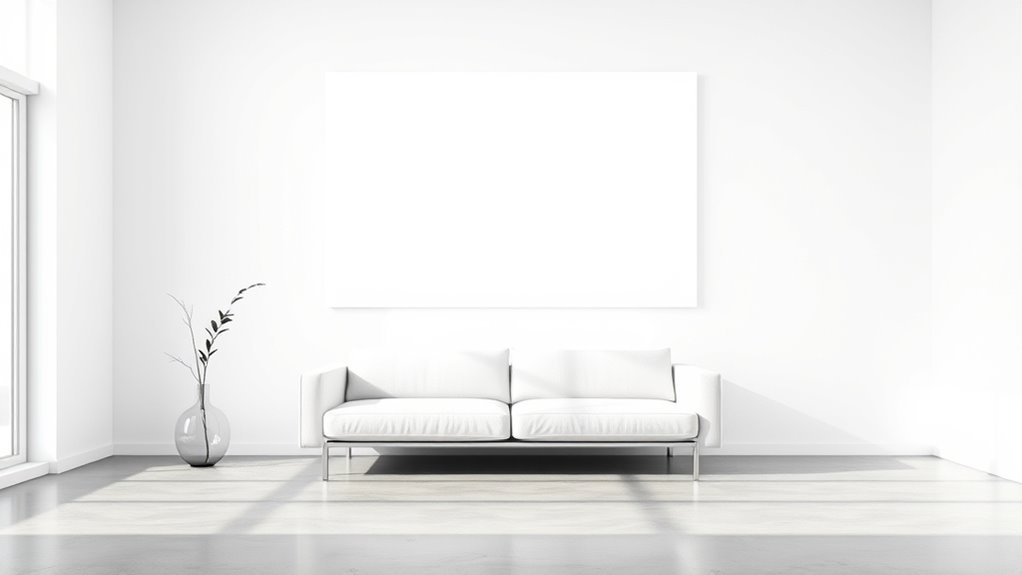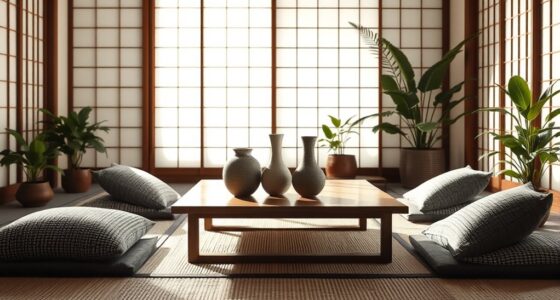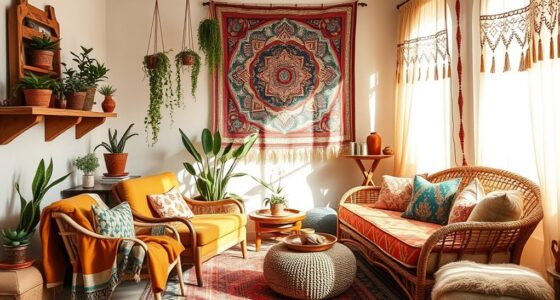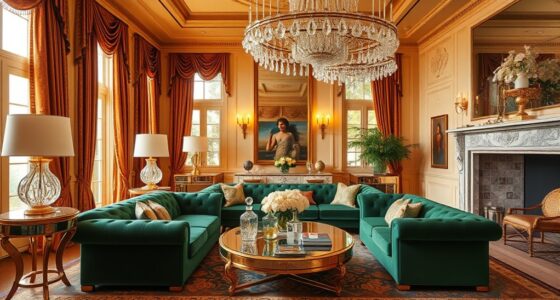If your space feels cold and uninviting, you might have over-applied minimalism by removing too many items or choosing stark, neutral tones without warmth. Relying solely on simplicity can create a sterile environment that lacks personality and comfort. Adding textures, warm accents, and curated decor can soften this effect and create a welcoming atmosphere. To transform your space into a calming sanctuary, understanding common mistakes and how to avoid them is key. Keep exploring for more tips.
Key Takeaways
- Overly sparse decor and lack of textures can make minimalist spaces feel sterile and uninviting.
- Eliminating all personal touches or cozy accents results in a cold, impersonal environment.
- Using only neutral tones and smooth surfaces without layered textures can create a hospital-like atmosphere.
- Focusing solely on removal without adding warmth or character leads to spaces that lack comfort.
- Ignoring the importance of balance and purpose can cause minimalism to feel more cold and distant than calming.
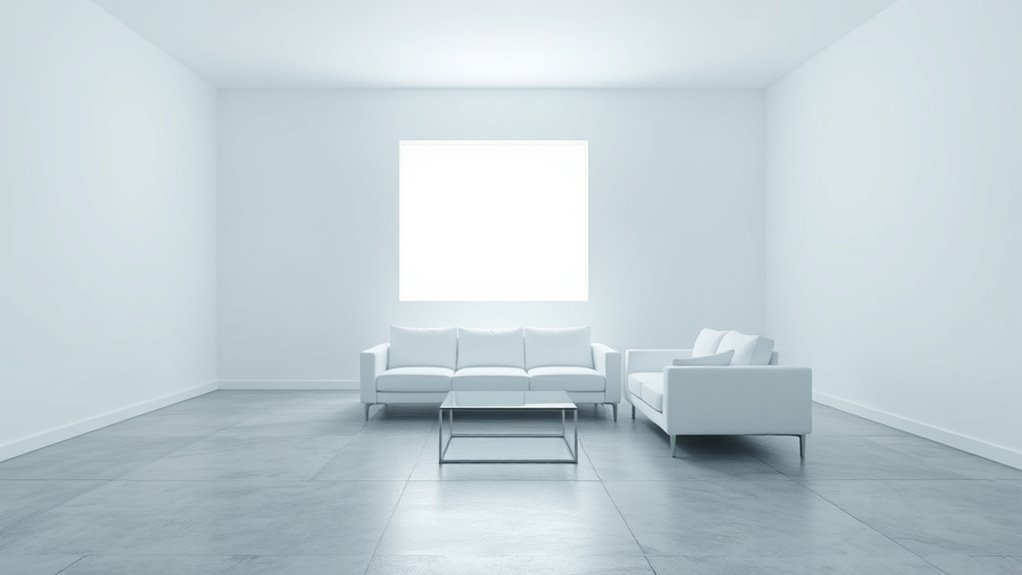
Minimalism often promises simplicity and clarity, but when misapplied, it can lead in confusion and frustration. One common mistake is mistaking minimalism for emptiness, which results in cluttered chaos rather than a peaceful space. You might think that removing everything will create calm, but instead, you end up with overdecorated interiors that feel disjointed and overwhelming. When you overdo the minimalism, it can backfire, making your space seem cold and uninviting instead of serene. The challenge is finding the right balance—stripping away excess without turning your home into a sterile environment.
If you fill your space with too many sparse, yet carefully chosen items, it often leads to a sense of emptiness rather than tranquility. This happens when you focus solely on minimalism as a way to eliminate everything, forgetting that a few thoughtfully placed objects can add warmth and personality. For example, a single piece of art or a cozy throw on the sofa can make a big difference. Without these touches, your space might look clean but also feel impersonal, like a showroom rather than a home. The key is to curate carefully, ensuring each item serves a purpose and contributes to the overall aesthetic without creating cluttered chaos or overdecorated interiors.
Another mistake is neglecting texture and color, which are essential in avoiding that cold, impersonal vibe. When your space is all neutral tones and smooth surfaces, it can feel stark and uninviting. You might think that sticking to whites, blacks, and grays will keep things simple, but it often results in a space that feels more like a hospital than a cozy retreat. Adding layers of texture—think soft rugs, woven baskets, or plush cushions—can soften the sharp edges of minimalism. Warmth isn’t about clutter; it’s about thoughtful accents that make your space feel alive and welcoming. Incorporating a variety of textures and colors can transform a minimalistic room into a warm and inviting sanctuary.
Finally, rushing to adopt minimalism without understanding its principles can lead you astray. It’s not just about removing everything, but about intentional design. You need to decide what truly matters and what adds value to your environment. Overdecorated interiors or a cluttered chaos of unnecessary objects defeat the purpose of minimalism. When done thoughtfully, however, minimalism can create a space that’s both calm and inviting. It’s about clarity, purpose, and balance—not just empty surfaces or overly sparse rooms. If you approach it with mindfulness, you’ll avoid those cold, uninviting spaces and instead craft an environment that feels peaceful and genuinely yours.
Frequently Asked Questions
How Can Color Choices Impact Minimalist Space Warmth?
Color choices greatly impact the warmth of your minimalist space. Using color psychology, warm hues like soft reds, warm beiges, or gentle oranges can create a cozy atmosphere. Achieving hue harmony ensures these colors complement each other, avoiding a cold, sterile feel. By thoughtfully selecting warm tones and balancing them with neutral shades, you make your space inviting and comfortable, transforming it from cold to calm effortlessly.
What Are Common Mistakes in Furniture Selection for Minimalism?
Think of furniture as the bones of your space; choosing the wrong pieces can make your room feel like a skeleton. Avoid clutter accumulation by selecting appropriately sized furniture—oversized pieces can overwhelm, while too small feels lost. Stick to simple, functional designs that breathe and flow, creating harmony rather than chaos. Your goal is a space that invites relaxation, not one weighed down by bulky or poorly scaled furniture.
How Does Lighting Influence the Mood of Minimalist Interiors?
Lighting greatly influences the mood of your minimalist space. An ambient glow creates warmth and comfort, making the room inviting. You can also use shadow play to add depth and visual interest without cluttering the space. Opt for soft, layered lighting instead of harsh overhead lights. This balance helps your space feel calm and cozy, rather than cold or sterile, enhancing the overall minimalist aesthetic with a welcoming atmosphere.
Can Minimalism Work in Small Spaces Effectively?
You can definitely make minimalism work in small spaces by carefully choosing decorative accessories and wall art. Keep clutter to a minimum, but add meaningful pieces that reflect your style. Use light colors and strategic lighting to make the space feel open and inviting. With thoughtful placement, even a small space can feel calm and cozy without feeling cold or cramped. Focus on simplicity and intentional decor to maximize your space’s potential.
What Role Do Textures Play in Creating a Welcoming Minimalist Environment?
Imagine a sleek minimalist living room where adding a soft wool rug creates textural contrast. Textures like plush cushions or tactile layering soften harsh lines and add warmth. You should incorporate varied textures to invite touch, making your space feel inviting rather than cold. By mixing smooth surfaces with cozy fabrics, you’ll foster a welcoming environment that balances simplicity with comfort, ensuring your minimalist space feels both calm and inviting.
Conclusion
To avoid making your space feel cold instead of calm, remember that minimalism isn’t just about empty surfaces. Incorporate warm textures and subtle pops of color to add life. Remarkably, a study shows that 68% of people find rooms with too much white space uninviting. By balancing simplicity with warmth, you create a welcoming environment that feels both peaceful and cozy, ensuring your minimalist space truly serves as a sanctuary rather than a cold, empty shell.
